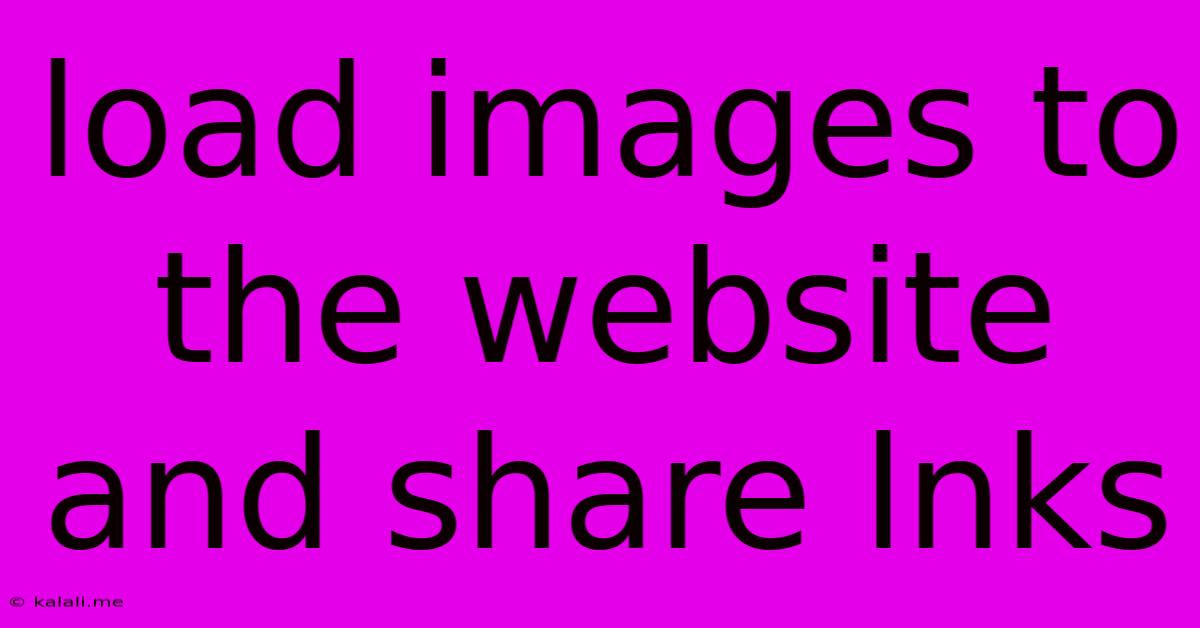Load Images To The Website And Share Lnks
Kalali
Jun 01, 2025 · 3 min read

Table of Contents
Loading Images to Your Website and Sharing Links: A Comprehensive Guide
This article will cover the best practices for loading images onto your website, ensuring optimal performance, and sharing those images effectively via links. We'll explore various methods, focusing on SEO best practices and user experience. This guide will help you improve your site's speed, search engine ranking, and overall appeal.
Choosing the Right Image Format
The format you choose for your images significantly impacts file size and quality. Here’s a breakdown:
- JPEG: Ideal for photographs and images with smooth color gradients. Offers good compression, resulting in smaller file sizes.
- PNG: Best for images with sharp lines, text, logos, and illustrations where transparency is needed. Generally larger file sizes than JPEGs.
- WebP: A newer format offering superior compression compared to both JPEG and PNG, resulting in smaller file sizes and better quality. Browser support is growing, but it's not universally compatible yet.
- GIF: Suitable for animated images and simple graphics. Compression is generally less efficient than JPEG or PNG.
Consider the image content and your target audience's browsers when making your selection. For most cases, WebP is the preferred choice if browser compatibility isn't a major concern. Otherwise, JPEG and PNG remain reliable options.
Optimizing Images for Web Use
Before uploading, optimize your images to reduce their file size without sacrificing quality:
- Resize Images: Use an image editor (like Photoshop, GIMP, or online tools) to resize your images to the dimensions needed for your website. Avoid uploading excessively large images.
- Compression: Utilize lossy compression (JPEG, WebP) to significantly reduce file size with minimal noticeable quality loss. Lossless compression (PNG) maintains image quality but results in larger files. Many online tools can help you compress images without compromising quality too much.
- Use appropriate image dimensions: Ensure your images are appropriately sized for their intended use to avoid unnecessary bandwidth consumption and slow loading times.
Uploading Images to Your Website
The process of uploading images varies depending on your website platform (WordPress, Wix, Squarespace, etc.). Generally, most platforms provide a user-friendly interface for image uploads through a media library or similar feature. Always use descriptive filenames (e.g., product-name.jpg instead of IMG001.jpg).
Sharing Image Links Effectively
Sharing images via links requires creating links that are easy to find and understand.
- Direct Image Links: Avoid directly linking to the image file itself (e.g.,
example.com/images/image.jpg). This bypasses your website's structure and can lead to broken links. Instead, link to the page where the image is hosted. - Using Image Alt Text: Always include descriptive alt text for all your images. This improves accessibility for visually impaired users and helps search engines understand the context of your images. This is crucial for SEO.
- Context is Key: Ensure the context surrounding the image is clear and relevant. The surrounding text should explain the image's purpose and how it relates to the overall content of the page.
Improving Website Performance with Image Optimization
Slow-loading images are a major cause of poor website performance. Here's how to improve this:
- Lazy Loading: Implement lazy loading to defer the loading of images until they are near the viewport. This reduces initial page load time. Most CMS platforms offer plugins or features for lazy loading.
- Image CDNs: Consider using a Content Delivery Network (CDN) to serve your images from servers closer to your visitors' locations. This improves loading speed for users around the world.
- Image Optimization Plugins: For platforms like WordPress, several plugins offer advanced image optimization features, including automatic compression, resizing, and lazy loading.
By following these guidelines, you can effectively load images onto your website, share them via links, and significantly improve your site's performance and search engine optimization. Remember that a good balance between image quality, file size, and loading speed is key to creating a positive user experience.
Latest Posts
Latest Posts
-
How To Wire A Four Way Switch
Jun 02, 2025
-
How Many Calories In A Cup Of Uncooked Rice
Jun 02, 2025
-
Why Do I Slice My Driver
Jun 02, 2025
-
Come The Dark Side We Have Cookies
Jun 02, 2025
-
Hold Me Closer Ed Its Getting Dark
Jun 02, 2025
Related Post
Thank you for visiting our website which covers about Load Images To The Website And Share Lnks . We hope the information provided has been useful to you. Feel free to contact us if you have any questions or need further assistance. See you next time and don't miss to bookmark.